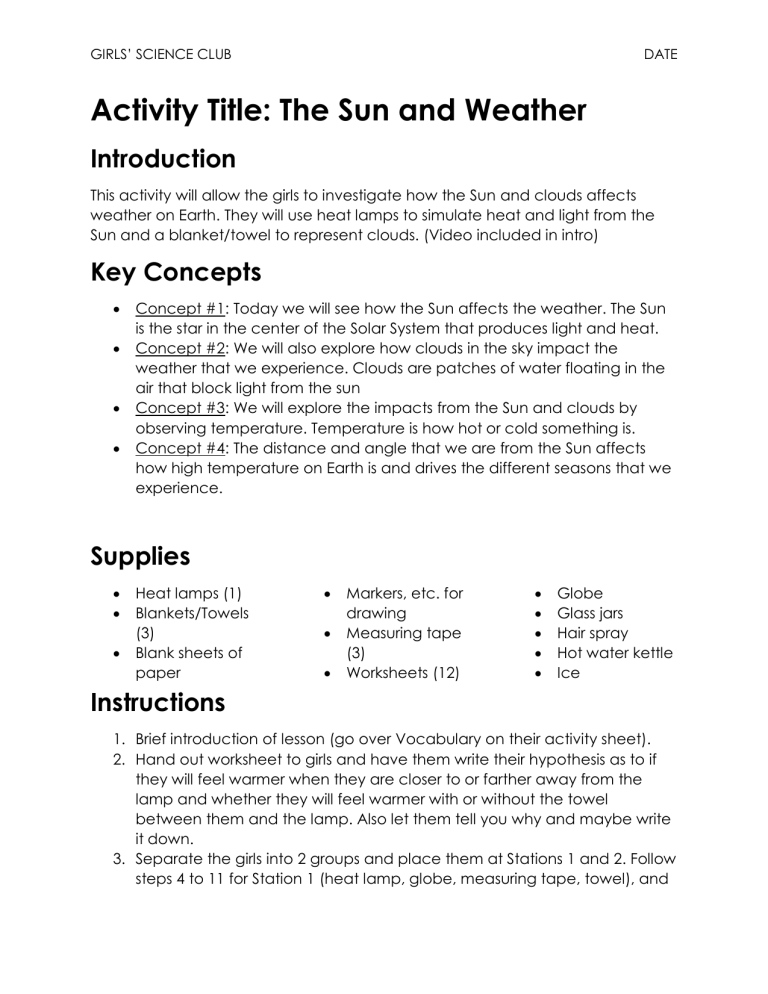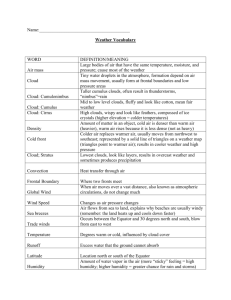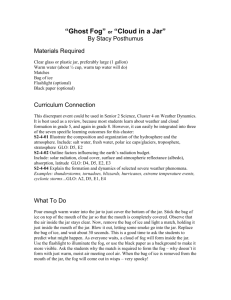Cloud in a bottle instructions

GIRLS’ SCIENCE CLUB DATE
Activity Title: The Sun and Weather
Introduction
This activity will allow the girls to investigate how the Sun and clouds affects weather on Earth. They will use heat lamps to simulate heat and light from the
Sun and a blanket/towel to represent clouds. (Video included in intro)
Key Concepts
Concept #1: Today we will see how the Sun affects the weather. The Sun is the star in the center of the Solar System that produces light and heat.
Concept #2: We will also explore how clouds in the sky impact the weather that we experience. Clouds are patches of water floating in the air that block light from the sun
Concept #3: We will explore the impacts from the Sun and clouds by observing temperature. Temperature is how hot or cold something is.
Concept #4: The distance and angle that we are from the Sun affects how high temperature on Earth is and drives the different seasons that we experience.
Supplies
Heat lamps (1)
Blankets/Towels
(3)
Blank sheets of paper
Markers, etc. for drawing
Measuring tape
(3)
Worksheets (12)
Globe
Glass jars
Hair spray
Hot water kettle
Ice
Instructions
1.
Brief introduction of lesson (go over Vocabulary on their activity sheet).
2.
Hand out worksheet to girls and have them write their hypothesis as to if they will feel warmer when they are closer to or farther away from the lamp and whether they will feel warmer with or without the towel between them and the lamp. Also let them tell you why and maybe write it down.
3.
Separate the girls into 2 groups and place them at Stations 1 and 2. Follow steps 4 to 11 for Station 1 (heat lamp, globe, measuring tape, towel), and
GIRLS’ SCIENCE CLUB DATE follow the “cloud in a bottle” instructions below for Station 2 (jar with lid, ice, hot water, hair spray). The students should go to each of the two stations at some point so we’ll switch groups at around say 6:00 – 6:10 pm.
After each group has completed Stations 1 and 2, take them to Station 3 and follow step 12 (drawing).
4.
Have the girls stand in front of the heat lamp in groups. Have them stand close so they can feel the heat, and farther away, where they cannot feel heat. Mention that the heat that they feel is a measure of the temperature and we can observe if we have warm temperatures or cool temperatures. Explain to them that the Sun makes a difference in the temperature we feel on Earth because the Sun is like a giant heat lamp, which sends rays of heat energy out in all directions. These rays include light, which we see, and heat, which we feel.
5.
Ask them what they notice about the heat coming from the lamp while guiding them toward the fact that as they move away from it, less heat reaches them. Let them record their observations in the 1 st table of the worksheet. We can talk about different planets here and explain why some planets are hotter than some. For example, Saturn’s moon, Titan (or another outer planet) is much cooler than Earth and the planet Mercury is much hotter than Earth.
6.
Have the girls stand at different angles (via distances) to the lamp. Explain to them that at different angles we experience less heat from the Sun.
Compare the different angles to what we experience at different times of the day (just as an analogy here).
7.
Again let them record their observations in the 2 nd table.
8.
Have the girls stand at different angles (via angling of their bodies) to the lamp. They can face the lamp straight on and then angle their bodies away from the lamp. Ask them what they observe and lead them to the fact that they feel more heat when facing the lamp straight on. Compare this to the different seasons. Explain that the seasons happen because
Earth is tilted, and the winter hemisphere is tilted away from the sun (less direct angle) and the summer hemisphere is tilted towards it (more direct angle). They can play around with the globe here to demonstrate this.
9.
Now have them stand where they can feel the heat from the lamp. Hold a towel/blanket between them and the lamp. Ask them to describe any
10.
changes. They should note that they no longer feel as much heat coming from the lamp.
Have them record this observation on the activity sheet illustration.
GIRLS’ SCIENCE CLUB DATE
11.
Compare this phenomenon to what we experience as a result of clouds in the sky and have them circle which day in Boston is warmer in the picture on the worksheet.
12.
Have them draw two scenarios and label warmer and cooler. They can choose whether they draw two pictures with different distances of the sun from the Earth or two that compares the cloud cover. At the end one must be warmer and one cooler. This can be a competition for a prize at the end. (At Station 3)
13.
Finally summarize what they learned today (distance and time of day, angle and seasons, clouds). Ask what they learn and distribute candy!
GIRLS’ SCIENCE CLUB DATE
Questions
1.
Why is it hottest at midday and coolest at sunrise and sunset?
2.
Why do we have different seasons?
3.
Do we feel cooler or warmer on a cloudy day? Why?
Take-home Message
You feel warmer when closer to the Sun
You feel warmer when at a direct angle to the Sun
You feel cooler on a cloudy day vs. a day with clear skies
Fun Facts
The equator does not experience changing seasons but have sun all year round. (If you guys can come up with better ‘fun facts’ please do!)
GIRLS’ SCIENCE CLUB DATE
Cloud in a bottle instructions:
(See the following link for video: http://www.kidspot.com.au/kids-activities-andgames/Science-experiments+10/How-to-make-a-cloud-in-a-jar+12511.htm)
Boil the kettle. Pour about 2cm of boiled water into the jar. Swirl the hot water in the jar so that it heats up the sides of the jar.
Turn the lid of the jar upside down and use it as a small container to put a few cubes of ice into. Rest it on top of the jar for a few seconds.
Take it off and quickly squirt in some hairspray (or whatever aerosol you're using). Put the lid, with the ice resting in it, back on top of the jar.
Watch the cloud form inside the jar. When it is fully formed, take the lid off and watch the cloud escape.
Why is it so?
The atmosphere needs three ingredients to make a cloud:
1. warm, moist air
2. cooling (which causes the moisture to lift)
3. cloud condensation nuclei or CCN
(Cloud condensation nuclei = a very small particle that can float in the air to help water vapour condense into clouds. In Hawaii, for example, the most common CCN are sea salt aerosols, but CCN can also be dust, smoke, air pollution or volcanic fog.)
Here's what happened to make your cloud
By pouring hot water into a jar and trapping it, you created warm, moist air. As the warm air inside the jar rose, it was then cooled by the ice on top of the jar.
When the water vapour cooled, it wanted to turn back into liquid, but it needed to condense onto a surface. The aerosol provided cloud condensation nuclei: a surface for the water vapour to condense into tiny cloud droplets.
The cloud swirled inside the jar due to the circulation of warm air rising and cold air sinking.







